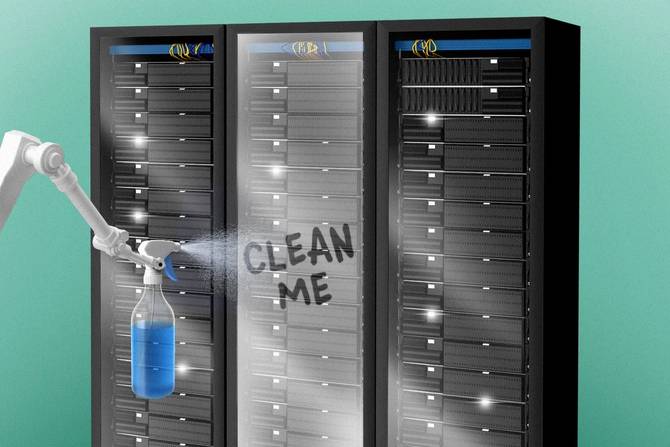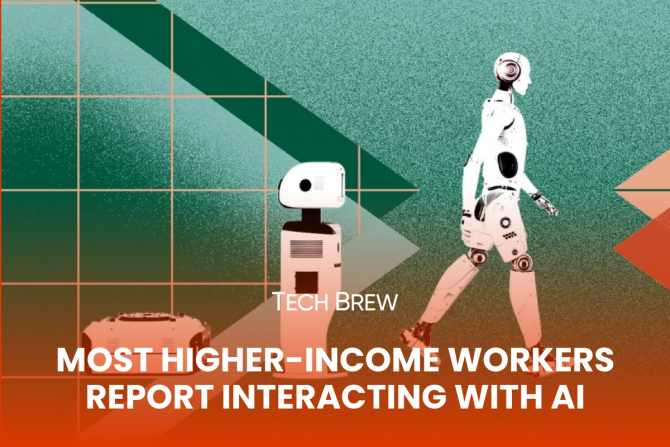Once again, Wednesday! Want to work from home? You’re not alone—88% of global workers feel the same way, according to a new Flexa survey.
In today’s edition:
 Cruel cuts Cruel cuts
 Home headaches Home headaches
 Boardroom blues Boardroom blues
—Eoin Higgins, Billy Hurley, Patrick Lucas Austin
|
|
Sesame/Getty Images
In a surprise move, network systems firm Cisco laid off employees in July.
The job cuts began July 17, sources told CRN, but the total number of affected employees is still unclear. In November, the company said it would lay off around 4,000 employees.
In a statement emailed to IT Brew, Justin Chinich, a spokesperson for Cisco, downplayed the July layoffs, saying they were simply “part of the rebalancing effort we began in November 2022, which included a limited restructuring impacting our real estate portfolio and approximately 5% of our workforce.”
“As we announced then, this is not about cost savings as we have roughly the same number of employees as we did before the process began,” Chinich said, adding that Cisco would try to place laid off employees elsewhere in the company.
Big picture. The layoffs come at a moment when economic concerns are lessening. Fears of a recession, which led many firms to rethink spending and hiring decisions, have faded from the front of mind for the C-suite.
According to TechCrunch, tech companies have reached the “pruning phase” of layoffs, as opposed to the more wholesale slashing of positions that the industry saw over the past year.
Those job cuts aside, the tech industry is healthy and hiring. As IT Brew has reported, there’s an existing talent deficit in the field that’s making tech workers feel overworked due to the lack of support.
Staff reaction. Posts on job forum board TheLayoff and Blind indicated Cisco employees had not expected the layoffs and were skeptical of the reasoning that they were part of a previously announced push.
Read more here.—EH
Do you work in IT or have information about your IT department you want to share? Email [email protected].
|
|
New tech, new consumer expectations, and new competitors, oh my! It’s an ever-evolving business landscape and digital world. Maintaining a digitally capable business can feel like running on a hamster wheel.
Hop off the wheel and start going places with Insight Enterprises. A Fortune 500 Solutions Integrator, Insight brings together a thoughtful IT road map that addresses your people, processes, and tech simultaneously to deliver value faster.
By bringing together products, services, ideas, and everything in between, Insight is your go-to partner for digital transformation, cloud, intelligent edge, data, AI, and cybersecurity.
Don’t get left in the digital dust. Simplify your most complex problems and start evolving with people and tech.
|
|
Branch
Executives are working from home but their cybersecurity practices are OOO, according to a survey from the research center Ponemon Institute and privacy-protection company BlackCloak that found that a large portion of C-suiters aren’t performing important protection practices while working remotely.
The lack of WFH safeguards—patch management, VPN usage, and two-factor authentication, to name a few—demonstrates weaknesses that attackers are especially happy to find given the value of their targets, who might be moving from the office to the couch.
“The issues of remote work and executives aren't an order of multitude; it's an order of magnitude,” said Lodrina Cherne, certified instructor for the SANS Institute in the digital forensics track.
In the May survey of 553 IT and IT security practitioners, 42% of respondents reported cyberattacks on key executives or their family members. Such cyberattacks against execs resulted in the theft of sensitive financial data, intellectual property, and company information.
And the consequences of a CEO-targeted attack can go beyond the executive.
“When you start talking about corporate attack surface, you start talking about shareholder confidence. This is where the idea of magnitude comes in, and all of the ripple effects,” said Cherne.
Other data points from the survey revealed a lack of remote readiness:
- “As security improves within organizations, cybercriminals are increasingly targeting individuals' private lives by attacking home networks and compromising unsecured devices with malware and ransomware,” read the report, citing tactics like doxxing, malware, infections, personal email attacks, and online impersonation.
- The report revealed a lack of visibility into personal devices (74% of respondents), executives’ personal email accounts (66%), the executives’ home networks to prevent cyberattacks (64%), and password hygiene (57%).
Read more here.—BH
Do you work in IT or have information about your IT department you want to share? Email [email protected].
|
|
Sihuo0860371/Getty Images
A June report from IANS Research, Artico Search, and The Cap Group says only 14% of CISOs have four out of five traits considered by many to be important for the boardroom: infosec tenure, broad experience, scale, advanced education, and diversity.
A high percentage of the not-really-ready-for-the-shareholder-suite security officers presents a challenge for organizations as the Securities and Exchange Commission proposes rule changes that require boards to designate cybersecurity expertise.
“Boards are probably going to scramble to figure out how [to] make an existing member check the box, whether it’s someone who’s been the CIO or that is overseeing technology, but it’d be great over time if we see opportunities for true security professionals to step in and truly serve in the capacity, because they have the experience and the knowledge,” Erica Wilson, VP, global cybersecurity and privacy risk management at Reinsurance Group of America, told a crowd at RSA this year.
In March 2022, the SEC proposed mandating a disclosure of “cybersecurity expertise” on the board. According to the IANS data, some CISOs are more prepared than others.
The IANS and co. review of CISOs from companies listed on the Russell 1000 Index, pulled from publicly available sources and self-reported info, found:
-
33% are “strong” candidates, meeting three out of the five board traits and nearly all having served as CISO for at least five years. The group, however, has “notably lower percentages for diversity and cross-functional experience than the pool of ideal candidates.”
-
52% are “emerging” candidates, only holding one or two of the desired characteristics—frequently infosec tenure and scale.
Keep reading here.—BH
Do you work in IT or have information about your IT department you want to share? Email [email protected].
|
|
Francis Scialabba
Today’s top IT reads.
Stat: 68%. That’s how many IT professionals reported getting a raise in the last year, according to a new ITPro Today survey. (ITPro Today)
Quote: “I feel like people with disabilities as a whole are more susceptible to online fraud.”—Tim Utzig, victim of Twitter scammers, on how predatory online thieves prey on people who use screen readers (WIRED)
Read: After buying a company with a worldwide recognized brand, Elon Musk has decided to turn Twitter into “X.” (New York Times)
Solutions and evolutions: Insight Enterprises is the Fortune 500 Solutions Integrator delivering high-quality digital transformation solutions. Help your biz roll with the punches of the ever-changing digital landscape. Check it out.*
*This is sponsored advertising content.
|
|
Francis Scialabba
|
A survey found that 90% of high earners have exposure to artificial intelligence in their work life—whether it’s from the big enterprise software players integrating generative AI into their product suite or being in the corporate suite making the big decisions on operational efficiency. Check it out.
|
|
|









